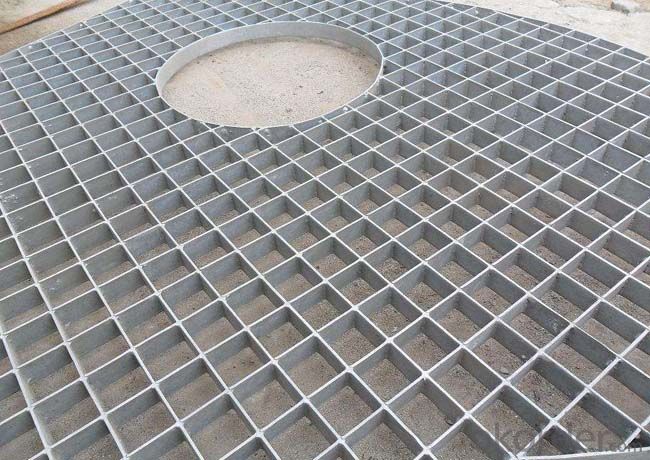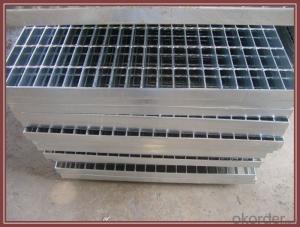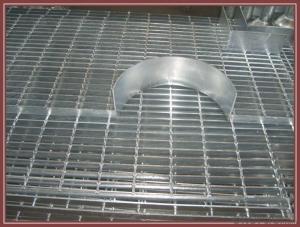Pressed And Forged Aluminum Flooring Grating/Grate/Grates
- Loading Port:
- Qingdao
- Payment Terms:
- TT OR LC
- Min Order Qty:
- 5000 pc
- Supply Capability:
- 6000000 pc/month
OKorder Service Pledge
OKorder Financial Service
You Might Also Like
1.Description of Drainage trench cover:
Drainage trench cover is widely used in the urban road, the square, the botanical garden, the wharf, the airport, the parking lot, the road, each kind of industry, the civil project, etc.
2.Main features of Drainage trench cover:
I--Carrying 20 tons of weight
II—Carrying 14 tons of weight
III---carrying 6 tons of weight
IV---carrying 2 tons of weight
V---Carrying pedestrian weight
3.Glass Wool Blanket Images:

4. Drainage Trench Cover Technical Parameters:
These drain cover plate applies to the road cross-sectional and longitudinal drain. The drains width ranging from 200mm to 550mm.
A means the steel grating length
H means the steel grating height
A means the frame length
H means the frame height
5.FAQ
We have organized several common questions for our clients,may help you sincerely:
①How about your company?
A world class manufacturer & supplier of Drainage trench cover is
one of the large scale professional investment casting production bases in China,consisting of both casting foundry forging and machining factory. Annually more than 8000 tons Precision casting and forging parts are exported to markets in Europe,America and Japan. OEM casting and forging service available according to customer’s requirement.
②How to guarantee the quality of the products?
We have established the international advanced quality management system every link from raw material to final product we have strict quality test; We resolutely put an end to unqualified products flowing into the market. At the same time, we will provide necessary follow-up service assurance.
- Q:What are the standard dimensions of aluminum profiles?
- The standard dimensions of aluminum profiles can vary depending on the specific industry and application. However, there are some common standard dimensions that are widely available. In general, aluminum profiles come in a variety of shapes and sizes, including rectangular, square, circular, and custom shapes. The most common dimensions for rectangular aluminum profiles are typically between 1 inch to 6 inches in width and 1/2 inch to 4 inches in height. Square profiles often range from 1 inch to 4 inches in width and height. Circular aluminum profiles, also known as tubes or pipes, are typically available in various outer diameters ranging from 1/4 inch to 8 inches, with wall thicknesses ranging from 1/16 inch to 1/2 inch. It's important to note that these are general standard dimensions and there can be variations depending on the manufacturer and specific requirements of a project. Additionally, custom dimensions can be manufactured to meet unique specifications. When selecting aluminum profiles, it's crucial to consider the intended application and load-bearing requirements to ensure the chosen dimensions can adequately support the intended use.
- Q:Who would like to know, aluminum radiator mainly used in which instruments or equipment, trouble to say more detailed points, thank you
- Application of aluminum radiator is quite extensive, you do not know where to, because he has the quality of light, and the price is reasonable, the general electronic instruments and equipment will be used, such as TV, audio amplifier, car circuit board, CPU computer graphics.
- Q:Can aluminum profiles be an alternative to steel in certain applications?
- Yes, aluminum profiles can be a viable alternative to steel in certain applications. Aluminum profiles offer several advantages over steel, making them suitable for specific use cases. Firstly, aluminum profiles are much lighter than steel, which can be advantageous in industries where weight reduction is critical, such as aerospace or automotive applications. The lower weight of aluminum profiles also makes them easier to handle and install in various construction projects. Secondly, aluminum profiles have excellent corrosion resistance properties. Unlike steel, which is susceptible to rust and corrosion, aluminum naturally forms a protective oxide layer on its surface, providing long-term protection against environmental elements. This makes aluminum profiles a preferred choice in outdoor applications or environments with high humidity or exposure to chemicals. Additionally, aluminum profiles have a higher strength-to-weight ratio compared to steel. Although steel is generally stronger, aluminum profiles can still provide sufficient strength for many applications while being significantly lighter. This characteristic makes aluminum profiles suitable for structures that require high strength but need to be lightweight, such as building facades or bridges. Furthermore, aluminum profiles have superior thermal conductivity compared to steel. This makes them an excellent choice for applications that require efficient heat dissipation or thermal management, such as heatsinks or heat exchangers. In conclusion, while steel remains the preferred choice in many applications due to its strength, aluminum profiles can be a viable alternative in certain situations. Their lightweight nature, corrosion resistance, high strength-to-weight ratio, and thermal conductivity make them ideal for specific industries and projects.
- Q:Are aluminum profiles suitable for decorative applications?
- Indeed, decorative applications can benefit greatly from the use of aluminum profiles. This material, known for its versatility, provides numerous advantages in decorative contexts. To start with, aluminum profiles can be easily shaped and molded into various designs, offering endless possibilities for decorative applications. Designers have the freedom to extrude them into different shapes, sizes, and patterns, allowing for the creation of unique and visually pleasing decorative elements. Furthermore, aluminum profiles exhibit excellent durability and resistance to corrosion, making them suitable for both indoor and outdoor decorative applications. Thanks to their rust and weather resistance, decorative elements made from aluminum profiles can maintain their appearance for an extended period. Moreover, aluminum profiles can be finished in different ways to enhance their decorative appeal. Anodizing or powder-coating can be applied to the surface, adding color, texture, and protection. These finishing options allow for customization and the ability to harmonize the profiles with the overall design scheme. Additionally, aluminum profiles possess the advantageous combination of being lightweight and strong, facilitating their installation and handling during the decorative application process. This characteristic is especially valuable in situations where weight is a consideration, such as with suspended or wall-mounted decorative elements. Finally, it is worth noting that aluminum is an environmentally friendly and sustainable material. It is entirely recyclable, and the production process of aluminum profiles requires significantly less energy compared to other materials. By choosing aluminum profiles for decorative applications, one aligns with sustainable design principles and contributes to reducing the environmental impact. In conclusion, the versatility, durability, corrosion resistance, customization options, lightweight nature, and sustainability of aluminum profiles make them highly suitable for decorative applications. Whether it is for interior or exterior decorative elements, aluminum profiles offer a wide range of possibilities to enhance the aesthetic appeal of any space.
- Q:3030 aluminum profiles, can be used in outdoor snow exposure environment?
- This refers to the 3030 heavy aluminum profiles. General aluminum profile manufacturers will make a number of their own products,
- Q:What are the different alloys available for aluminum profiles?
- Aluminum profiles have numerous alloy options, each with its own distinct properties and characteristics. Some widely used alloys include: 1. 6061-T6: This alloy is extensively utilized for aluminum profiles due to its exceptional strength, resistance to corrosion, and weldability. It finds application in structural components like frames, beams, and supports. 2. 6063-T5: Known for its excellent formability and ability to be extruded, this alloy is perfect for creating intricate shapes and designs. It possesses good corrosion resistance and is commonly employed in architectural projects such as window frames and curtain walls. 3. 7075-T6: This alloy offers remarkable strength and toughness, making it suitable for demanding applications such as aerospace components and high-stress structural parts. 4. 6082-T6: Similar to 6061-T6 in terms of strength and corrosion resistance, this alloy offers enhanced machinability. It is frequently utilized in the automotive and transportation industries. 5. 3003-H14: This alloy is primarily chosen for its excellent resistance to corrosion. It finds application in marine settings, as well as in chemical and food processing industries. These examples represent only a fraction of the available aluminum profile alloys. The selection of the appropriate alloy depends on specific requirements, such as desired strength, corrosion resistance, formability, and machinability, for a given application.
- Q:Can aluminum profiles be used in the manufacturing of furniture?
- Furniture production can utilize aluminum profiles, which are versatile and lightweight materials. Aluminum possesses numerous advantages for furniture manufacturing, such as durability, corrosion resistance, and a high strength-to-weight ratio. Due to these properties, it is suitable for various furniture applications, including chairs, tables, shelving units, and frames. Moreover, aluminum profiles offer easy customization, enabling the creation of distinctive and contemporary designs. By incorporating aluminum into furniture manufacturing, sustainability is promoted as it is a recyclable material. In conclusion, aluminum profiles offer flexibility and durability to designers and manufacturers, rendering them a favored option in the furniture industry.
- Q:What are the different bending radii available for aluminum profiles?
- The different bending radii available for aluminum profiles can vary depending on the specific profile and its dimensions. However, common bending radii for aluminum profiles typically range from 1.5 to 3 times the profile's wall thickness.
- Q:What are the different surface sandblasting options for aluminum profiles?
- There are several surface sandblasting options for aluminum profiles, including: 1. Aluminum oxide blasting: This involves using aluminum oxide particles to remove surface impurities and create a smooth finish on the aluminum profiles. It is commonly used for cleaning and preparing the surface before further treatments or coatings. 2. Glass bead blasting: Glass beads are used to blast the aluminum surface, which helps to remove oxidation and provide a satin-like finish. This method is often employed for decorative applications or to achieve a specific aesthetic look. 3. Walnut shell blasting: Crushed walnut shells are used as the blasting media to gently remove contaminants and provide a smooth, matte finish on aluminum profiles. It is a non-aggressive option that is suitable for delicate or sensitive surfaces. 4. Steel shot blasting: Steel shot particles are propelled onto the aluminum surface to remove scale, rust, and other imperfections. This method is ideal for heavy-duty cleaning and surface preparation, especially for profiles that will undergo subsequent coatings or treatments. Overall, the choice of sandblasting option for aluminum profiles depends on the desired outcome, surface condition, and the specific requirements of the application.
- Q:Are aluminum profiles suitable for use in automotive body structures?
- Yes, aluminum profiles are suitable for use in automotive body structures. Aluminum is lightweight, strong, and corrosion-resistant, making it an ideal material for constructing car bodies. Its high specific strength allows for increased fuel efficiency and better performance. Additionally, aluminum profiles can be easily shaped and formed to meet the specific design requirements of modern vehicles.
1. Manufacturer Overview |
|
|---|---|
| Location | |
| Year Established | |
| Annual Output Value | |
| Main Markets | |
| Company Certifications | |
2. Manufacturer Certificates |
|
|---|---|
| a) Certification Name | |
| Range | |
| Reference | |
| Validity Period | |
3. Manufacturer Capability |
|
|---|---|
| a)Trade Capacity | |
| Nearest Port | |
| Export Percentage | |
| No.of Employees in Trade Department | |
| Language Spoken: | |
| b)Factory Information | |
| Factory Size: | |
| No. of Production Lines | |
| Contract Manufacturing | |
| Product Price Range | |
Send your message to us
Pressed And Forged Aluminum Flooring Grating/Grate/Grates
- Loading Port:
- Qingdao
- Payment Terms:
- TT OR LC
- Min Order Qty:
- 5000 pc
- Supply Capability:
- 6000000 pc/month
OKorder Service Pledge
OKorder Financial Service
Similar products
New products
Hot products
Related keywords
































